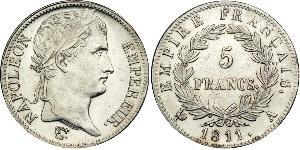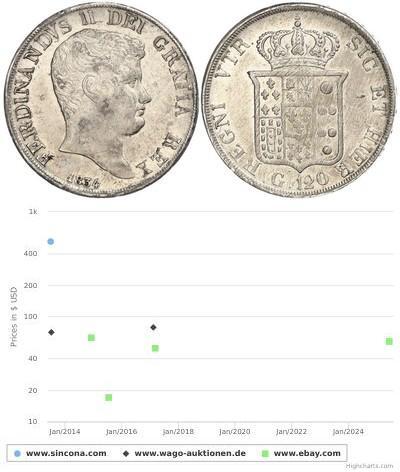8 Real (售价 $151.0)
1793, Mexico, Charles IV. Colonial Silver 8 Reales (Spanish Dollar) Coin. XF!
This currency was legal tender in the USA until 1857!
Mint Year: 1793
Condition: A nice XF!
Denomination: 8 Reales
Reference: 1793-MoFM, KM-109.
Assayers: Francisco de la Pena / Mariano Rodriguez
Mint Mark: Mo (Mexico in Monogram).
Material: Silver (.903) .7259 oz ASW.
Diameter: 39mm
Weight: 26.8gm
Obverse: Laureate, draped, and cuirassed profile bust of Charles III with roman armor right.
Legend: CAROLUS . IIII . DEI . GRATIA . 1793
Translation: "Charles IV by the Grace of God, 1793"
Reverse: Crowned Spanish* arms between the Pillars of Hercules adorned with PLVS VLTRA motto.
Legend: .HISPAN[IARUM].ET IND[IARUM].REX.Mo[Mexico Monogram].8R [EALES] F.M.[Assayer Initials]
Translation: "King of the Spains and the Indies, Mexico [Mint], 8 reales".
Pillar coins were a great improvement over cobs in that they were of a uniform size and weight without cracks or uneven edges. They had a deep full strike with all information clearly visible and were difficult to clip or counterfeit. Denominations for this new coinage included the one half, one, two, four and eight reales coins.
Portuguese merchant ships first arrived on the Chinese coast in 1517. The traders came to buy luxury goods such as silk and porcelain, for which the Chinese favoured payment in silver. As a result, during the eighteenth century European silver coins were exported to China in great quantities, through trade. At one stage almost the only coins used in southern China were European silver coins. Most of this silver was Spanish, much of the metal coming from the Spanish silver mines of the New World. In order to increase trade, the Spanish colonial administration at Manila in the Philippines arranged for silver coin from her American colonies to be shipped directly to Manila. The best known of these coins were the famous 'pieces of eight', the 8 reales piece. Chinese merchants in Manila then carried the silver coin to China where it circulated, mainly in the south-east. The use of silver coins in Chinese trade continued well into the nineteenth century, when silver dollars were often melted into ingots to provide payment as tax. Chopmarks on this 8 reales piece indicate that a Chinese money-changer has tested the quality of the silver. Forgeries were a common problem and cutting into the coin showed whether it was solid silver or just silver coated.
J. Williams (ed.), Money: a history (London, The British Museum Press, 1997)
W. Bertsch, 'Chinese chops - a bibliographical survey of Western publications', Oriental Numismatic Society In, 29 (January 1998)
Charles IV (November 11, 1748 - January 20, 1819) was King of Spain from December 14, 1788 until his abdication on March 19, 1808.
Charles was the second son of Charles III and his wife Maria Amalia of Saxony. He was born at Portici, while his father was king of the Two Sicilies. His elder brother don Felipe was passed over for the two thrones as mentally retarded and epileptic.
Charles had inherited a great frame and immense physical strength from the Saxon line of his mother, granddaughter of August II of Poland. When young he was fond of wrestling with the strongest countrymen he could find. He was considered by many to be intellectually sluggish and quite credulous.
His wife Maria Luisa of Parma, on the other hand, was seen by many (including by the painter Francisco Goya) as a vicious and coarse woman who thoroughly dominated the king. During his father's lifetime he was led by her into court intrigues which aimed at driving the king's favourite minister, Count of Floridablanca, from office, and replacing him by Pedro Pablo Abarca de Bolea, Count of Aranda, the chief of the "Aragonese" party.
After he succeeded to the throne in 1788 his one serious occupation was hunting. Affairs were left to be directed by his wife and her, alleged, lover Manuel de Godoy. Although Godoy essentially took over his wife and his office, the king was favourable towards him for all his life. When terrified by the French Revolution he turned to the Inquisition to help him against the party which would have carried the reforming policy of Charles III much further. But he never took more than a passive part in the direction of his own government. He simply obeyed the impulse given him by the queen and Godoy. In 1803, after smallpox had affected his daughter MarÃÂa LuÃÂsa, the king commissioned his doctor Francisco Javier de Balmis to bring the vaccine to the Spanish colonies on state expenses.
He had a profound belief in his divine right and the sanctity of his person. He thought it very important to seem a very powerful monarch, although his kingdom was treated as a mere dependency by France and his throne was dominated by the queen and her lover. Spain allied with France and supported the Continental Blockade, but withdrew after the Battle of Trafalgar. When Napoleon won from Prussia in 1807, Godoy returned to the French side, but France no longer considered Spain a worthy ally. But even the alliance with France, as it was, made Godoy's rule unpopular and fueled the partido fernandista, the supporters of Ferdinand, who favored a close relationship with Great Britain.

|
发布人:
anonymous 2014-03-04 |
|
||
|
||
|
||
|
||
|
||
其中一个是

-600-300-4NEKb0OM2aoAAAFEp54AgIsH.jpg)

-300-150-fP7BwcI0InEAAAEoDHP7lKXR.jpg)
 Deutsch
Deutsch Русский
Русский Українська
Українська English
English Italiano
Italiano Français
Français Español
Español 汉语
汉语












